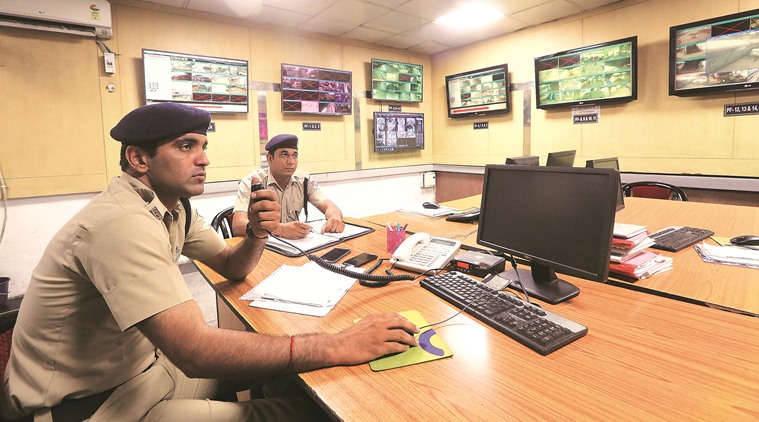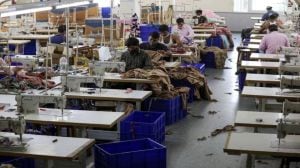Stay updated with the latest - Click here to follow us on Instagram
The eyes have it
While the administration in Delhi is caught in a deadlock over CCTVs, 152 cameras across New Delhi railway station watch as passengers set off on new journeys, others get left behind, and the odd drunk man strays in
 At the CCTV control room, 11 LCD screens spilt into 16 mini-screens, which continuously display images from 152 cameras that relay recordings from the 16 platforms of the railway station. Tashi Tobgyal
At the CCTV control room, 11 LCD screens spilt into 16 mini-screens, which continuously display images from 152 cameras that relay recordings from the 16 platforms of the railway station. Tashi Tobgyal
TUM SABKI video banake suspend karwaunga (I will make videos of all of you and get you suspended),” the man says, staggering towards the constables. From the far end of the room, a lone camera watches.
His drunken bravado has come at the end of a few minutes of commotion at New Delhi railway station’s Closed-Circuit Television (CCTV) control room. The man had been caught wandering in the station without a ticket, after which he had got into a fight with personnel of the Railway Protection Force (RPF). Here, at the control room, there is another scuffle and the man lunges at one of the constables and sinks his teeth into the policeman’s arm. The RPF personnel react swiftly and take him down, before leading him away.
For constables Vikas, 27, and Karampal, 26, such distractions are par for the course. Part of 30 CCTV operators deputed by the RPF to man this control room, they are on the 8 am to 8 pm shift. “Today, it’s just the two of us on this shift, but some days, there are more operators. It’s up to Rawat sir (O P Rawat, the Inspector in charge of the RPF unit at the New Delhi station),” says Karampal.
Located on Plaform No 1 of the station, near Gate No 1, the control room is the RPF’s nerve centre, coordinating with more than 300 officers across the railway station — passing on crowd-control tips, alerting constables about suspicious activities and helping lost children reunite with their parents.
In the centre of the room are two rectangular tables with four desktop computers that are connected to 11 LCD screens on two adjacent walls. Each of these LCD screens spilts further into 16 mini-screens, which continuously display images from 152 cameras that relay recordings from the 16 platforms, footover bridges, staircases and circulating areas of the station. As per protocol, the room can never be left without an operator.
Officials of the RPF — which has been tasked with operating the CCTV control room here — say that with more than five lakh passengers entering the station every day, the CCTV cameras provide a much-needed security blanket and are a vital part of the integrated security system, which includes the screening of passengers and their bags, and a bomb detection and disposal system.
CCTVs are the latest flashpoint in the national Capital between the AAP-led government and Lieutenant Governor Anil Baijal. With the L-G opting to constitute a panel to discuss the project, AAP leaders have accused him of derailing what was a key poll promise of the AAP government. It has been four hours since the two constables took over from the night shift operators. After the mandatory entry in the duty register — of the cameras that had malfunctioned the previous night — the two settle down at the desk.
They stay this way for hours, their eyes darting from one screen to another, seeing what the 152 cameras see — a teeming, shapeless mass of humanity that temporarily organises itself only to break formation with every train that pulls into the station. Women in sarees tugging their children along; wiry men lugging bags — their struggles captured by CCTV cameras and stored for seven days in a 30-terabyte-capacity server at the control room.
It’s 12.20 pm and the Purva Express has arrived. “Platform number 16, call on,” Vikas says into his walkie-talkie. A voice booms back: “Carry on CCTV New Delhi.” It’s radio lingo to say all lines are up, explains Vikas. Sitting behind the table, Vikas uses the mouse of the desktop computer to zoom into the images being relayed by Camera No 93 on Platform No 16.
The screen shows passengers making a mad dash towards the train that’s now slowing down, frantically looking for the unreserved coach. Karampal relays a message on his walkie-talkie, instructing the RPF staff on the ground to control the crowd. Some of the passengers jump right into the general coach, others fling their bags and then do the same with their children. Karampal asks for personnel to be sent to the unreserved coach.
Today, 25 of the mini-screens are not functioning. “Most of these are from cameras at Platform No 1. They have been switched off as the tracks are being renovated. But we are concerned about two cameras at Platform No 14 which are unable to focus and one camera at Platform 8 that somebody seems to have moved,” says Karampal.
Rawat, the Inspector in charge, explains that there are two kinds of cameras at the station — 96 fixed-point cameras and the 56 Point Tilt Zone ones, which are used to zoom into neighbouring areas such as Ajmeri Gate and Paharganj. Purvi Express has finally departed, but the two operators cannot relax just yet. Two RPF officers, dressed in civil clothes, walk in. “Look at footage from 11.45 am. From checking area-1,” one of the men instructs Karampal.
Karampal clicks on the server option of LCD Screen 1, where the footage is stored. After struggling for a few minutes, he says, “The server has been acting up for a while.” The team leaves. Every few minutes, someone walks into the room — either fellow RPF personnel who have dropped in for a chat or officers asking for playbacks of a particular footage.
Around 3:30 pm, the walkie-talkie finally falls silent and they decide to take a coffee break. As they sit back, Karampal and Vikas talk about the their lives back home. Karampal, a BCom graduate from Haryana’s Rewari district, says he wanted to join the Delhi Police and had even “cleared the physical examination, but while I was waiting for the results, I got this job.” Vikas, who is also from Haryana, says he joined the RPF after his Class 12. “At least I have a salary to take home,” he says, preparing to get back to work.
A couple of hours later, at 5.55 pm, there’s a crisis — four LCD screens go blank and 64 mini-screens display a ‘no signal’ message. The walkie-talkie comes alive, “CCTV on?”. “Yes, carry on,” Karampal replies. An agitated voice booms back, “Sampoorna Karanti kahan se ayegi? (Where will the Sampoorna Kranti train come from?) The footover bridge? People are waiting at Platform No 16.” Things are not looking good for the two operators. The cameras at Platform 15 and 16 are still blank. Several tense minutes pass as they wait for the train to arrive. It finally does, at Platform 16. The field staff are left to manage on their own.
Back in the control room, as a maintenance operator strides in, Vikas and Karampal breathe a sigh of relief. The operator is from the Signal and Telecommunications (S&T) department of the Railways, which maintains the software that runs the CCTV network. “These cameras have to be maintained every day,” says the S&T official. “In foreign countries, CCTVs work much better as they don’t have to deal with dust and heat. In Delhi, the cameras break down due to the heat.”
Just then, a voice booms over Karampal’s walkie-talkie. Inspector Rawat wants them to find a lost child — separated from his parents around 6.15 pm. The child was last seen near one of the foot-over-bridges. Thankfully, the cameras in the area are functional, but they can’t see the child on any of the screens. Karampal calls the RPF personnel stationed at these spots, but no one has seen the child. The two operators fall back on their knowledge of the station and make an educated guess. “He must have gone to Platform No 8,” says Vikas, who is met with a nod of disapproval from Karampal, who thinks the child would have reached Platform No 9.
Within minutes, Rawat calls again on the walkie-talkie, informing them that the child had been found — on “Platform-8”. Vikas smiles broadly, stepping out for a break. Just then, the 11 LCD screens also come back to life. Around 6.40 pm, a surprise dust storm engulfs the station. The footage from cameras 95 and 67 sway and the feed from camera 154 is grainy. As the wind blows harder, thefootage from platforms 14, 15 and the circulating areas start to shake. At Platform No 14, a crowd patiently waits in a line, the women covering themselves with veils, the men buffeted by the wind.
As he waits for his shift to end, Karampal says, “We know every nook and cranny of the station. But we are blind when the cameras malfunction.”
At the far end of the control room, the lone CCTV camera is still watching.







